This is part 6 of a 7-part series on Holland (The Netherlands), including traveling to Holland, the Dutch culture, Dutch lifestyle, Dutch environment and essential things to know about the country.
- Part 1: Introduction & Basic Information about Holland
- Part 2: Traveling to Holland: Visa Preparation and Climate
- Part 3: The Dutch Culture, Part 1
- Part 4: The Dutch Culture, Part 2
- Part 5: Living in Holland: Cost of Living and Hobbies
- Part 6: Traveling in Holland: Land of Bicycles, Public Transport and Going to Other EU Countries
- Part 7: 22 Random Facts About Holland
Land of Bicycles
Holland is also known as the Land of Bicycles. Before I came to Holland, some readers have already alerted me on the proliferation of bicycles in the country. But nothing beats seeing it in person!! Check this out!

Everyone and their grandmother know how to ride a bicycle in Holland. Seriously.
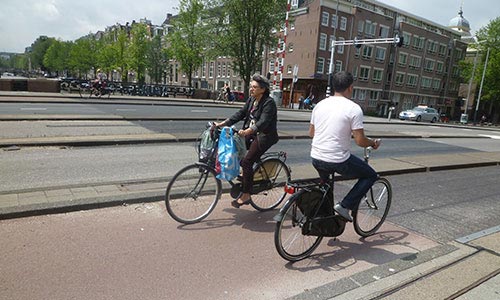
There are even bicycle-only road tracks built for cyclists.
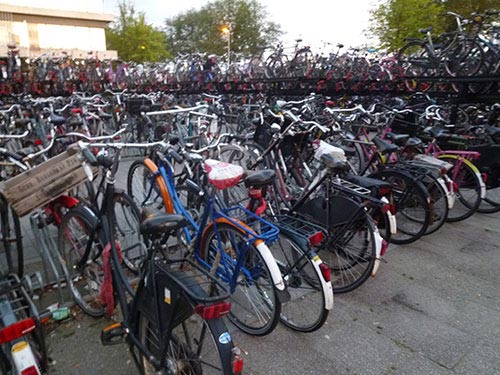
Check out the massive number of bicycles here!! This was taken beside Utrecht Central Station. My Dutch friend told me there used to be only 1 rack for bicycle storage, but then it was always full. So the government installed a second rack. Now the second rack is always full too! Time for a third rack?!

Bicycles galore. I’ve never seen so many bicycles in one place in my life.
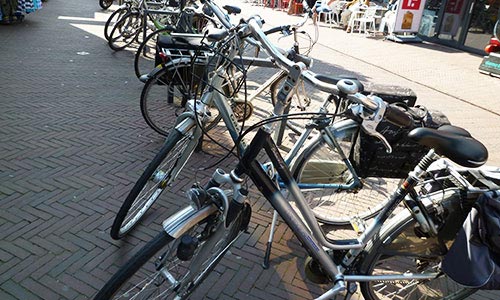
You’ll almost always see some bicycles parked outside a shop or along the road.
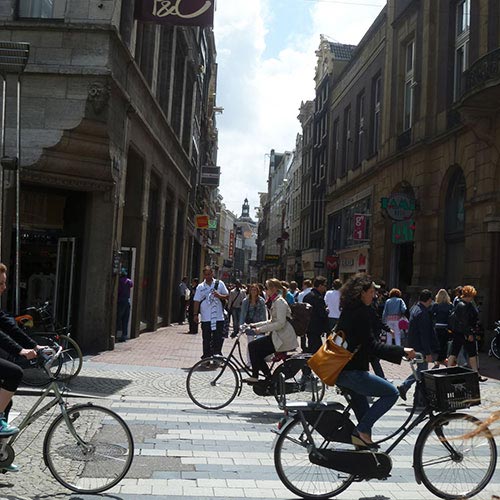
When you’re trying to take a picture of the surroundings and somehow cyclists get captured in the picture one way or another, you know for sure you’re in Holland.
There’s a running joke that there are more bicycles than people in the country, and I don’t think it’s untrue. Seems like it’s normal for every Dutch person to own an average of 2-3 bicycles!
The (Hidden) Merits of Cycling
While cycling may seem like a laborious/unglamorous mode of transport at first sight because you’re “working” and sweating and all, it quickly shows itself to a top choice when commuting.
- Great form of exercise. The average person in Holland is quite in shape. I’ve barely seen any overweight or obese person since I’ve been here. Since almost everyone cycles here, everyone gets his/her dose of exercise every day on the way to work or when running errands. Talk about effectiveness!
- Environmental friendly. There’s no fuel needed, which means a step towards preserving the limited resources in the world. It also means there are no byproducts from combustion to deal with.
- Economical. Other than the initial cost of buying a bicycle, everything else is free.
- Convenient. Takes you directly from one place to another, whereas with the tram/bus, you usually have to walk to cover the remaining distance.
- Fun. Wind blowing in the face, ever-changing scenery around you, all while getting a good workout – What’s not enjoyable about it?
If you’re planning to stay in Holland for an extended period of time, you should most definitely buy/rent a bicycle. It’ll save you a lot; not to mention it’ll be very convenient.
Since I don’t know how to cycle, I didn’t join in the cycling crowd. Which is okay with me as walking gives me more time to enjoy the scenery and surroundings. ;)
Through cycling, I discovered one of my most thrilling experiences in Holland – being the pillion passenger!! So far I’ve done it twice, and it was exhilarating. The first time I did it, it was late at night and it felt very surreal. The second time was in the evening when my Dutch friend and I were out shopping for groceries. I was very excited and was going around saying “hi” to the cyclists that we rode past, much to their shock, lol! :lol:
It’s probably something to do with the lack of control (being behind the bicycle and not knowing where it’s going) that makes this so very exciting. Either way, I highly recommend everyone to try it once in his/her lifetime! I’ve 2 outings next week where my friend is going to pillion me around Holland. I totally look forward to that. :D
Traveling Within Holland – Public Transport
If you don’t ride a bicycle like me, the public transport will be your good friend. Unlike in Singapore where public transport is limited to just buses, trains and taxis, in Holland, there are 5 modes of public transport:
1. Trams
These travel within the city and are only found in cities like Amsterdam. They operate on a fixed time schedule, which you can find at the tram stop. You can also see all the tram stops each tram services at the stop. Average wait time between trams is about 10-12 minutes.
I took the tram quite often while I was staying in Amsterdam. For the most part, it’s quite convenient and brings you to most places.

A tram in Amsterdam Central
2. Buses
Buses travel both within the city and outside the city. Usually, they’re mutually exclusive with trams – in places where there are trams, there aren’t buses; in places where they are buses, you don’t find trams.
In my Holland trip, I’ve only taken the bus when traveling from Hoofddorp to Schiphol Airport and from Hoofddorp to Amsterdam, which cost about $1.50 Euros each.
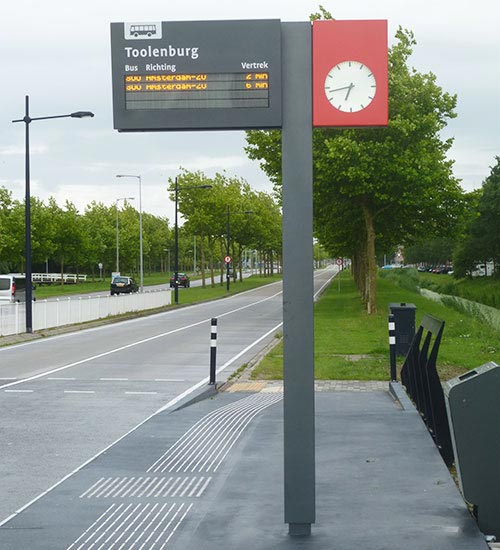
A bus stop at Hoofddorp
3. Metro
Then there’s the metro, which is a train that runs within the city. It’s like the MRT in Singapore.
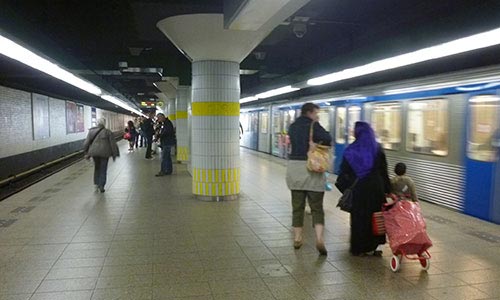
Inside the Waterloopein Metro Station (Amsterdam)
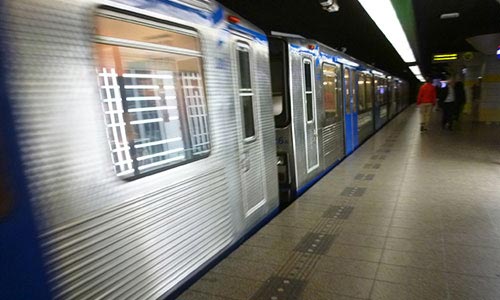
Metro trains are silver and blue in color
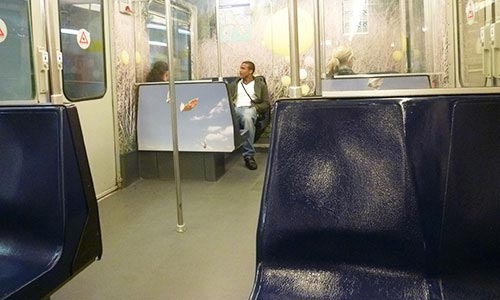
A look inside a metro
View the metro map for Amsterdam.
4. Intercity Train
Intercity trains run from one city to another – for example, from Den Hague to Amsterdam, or Amsterdam to Utrecht, or Utrecht to Nijmegen, and so on. The stations tend to be bigger and busier than the metro stations.

At Utrecht Central Station
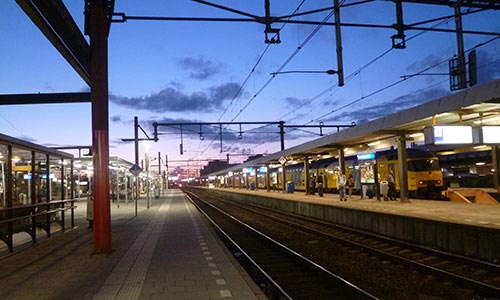
Intercity train stations are much larger than the metro stations. Also, it’s not unusual to find convenience stores and vending machines in the stations too.
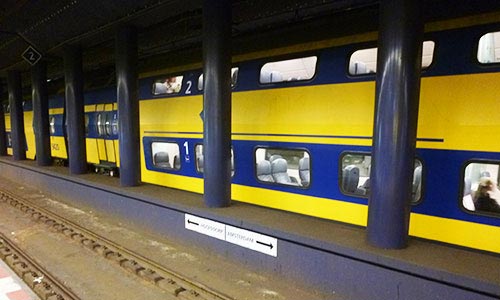
The intercity trains can be identified by the characteristic yellow and blue colors
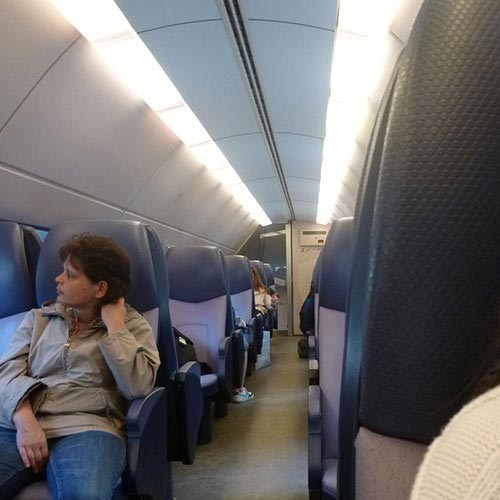
A look inside an intercity train
5. Taxis
Taxis are rare in Holland – You will almost never see a cab on the street until it’s near midnight. The only way to reliably get a cab is via booking.
The only time when I took a taxi was when I just arrived at the airport, and even then it was pre-arranged by my clients to take me to the hotel. Other than that I never had the need to take a taxi.

The taxi that fetched me from the airport. People in Holland drive on the right-side of the road, so the cars have a left-hand drive configuration (i.e. steering wheel is on the left side of the car)
Getting the Chip-Kart
While you’re in Holland, you should purchase the Chip-Kart. It’s a prepaid card for transport purposes, like the EZ Link card in Singapore or Octopus in Hong Kong. It can be used for trams, buses, metro and intercity trains – essentially all main public transport.
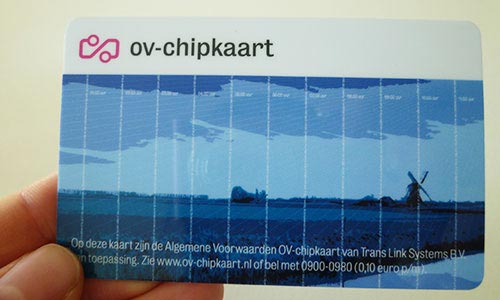
An example of the chip-kart. This is the card I use to get around Holland.
Always remember to tap out your Chip-Kart via the check-out machines after every ride. Some metro/intercity stations do not have exit gates (they are open space) – Instead, they have stand-alone check-out booths scattered about the platform. You have to manually tap your card, else you’ll get the maximum fare deducted (which can be huge, especially for intercity travels!).
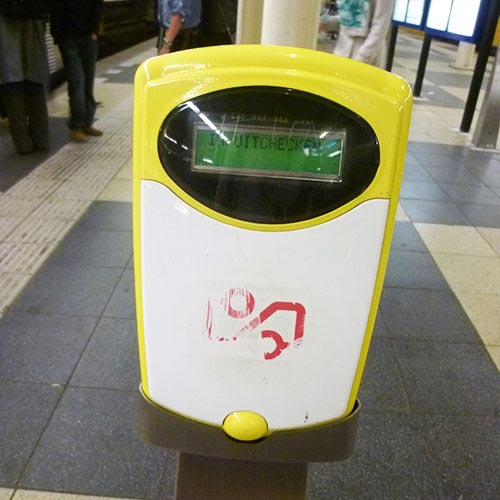
A check-in/check-out booth at Amstel Metro Station
Traveling from Holland to Another European Country
There are 3 ways of traveling around in Europe – by train, plane or car. I haven’t taken any of these yet, though it’s a matter of time when I start traveling to other parts of Europe.
1. Train
The great thing about Europe is that it’s well connected via train. You can travel to almost any European country via train. And guess what – there aren’t passport checks when you travel from one country to another within the Schengen Area! That’s the whole point of the Schengen Agreement – to remove the barriers when traveling from one EU country to another.
These resources will be handy:
- Interrail Net – A site where you can view major train routes in Europe, find train schedules and travel times, and buy your train tickets
- Bahn – Another site where you can check out travel offers within Europe and Germany and buy tickets
- The Man in Seat Sixty-One – One-stop resource for all tips and advice on traveling by train anywhere in the world
Usually, the earlier you book your train tickets, the cheaper they will be.
The upside of taking the train over the plane is that it is (1) Experiential – You get to enjoy the European scenery during the trip – as well as witness the transition in sight when moving from one country to the next, and (2) More effective – No need for baggage check-ins/retrievals and a lot of administrative mumbo-jumbo at the airports that take up a big chunk of time.
2. Plane
There are many budget airlines that connect the European countries. The most popular ones:
Sometimes the plane is cheaper; Sometimes the train costs less. You have to check the prices beforehand.
Note that while budget airlines may quote very low airfares, it usually doesn’t include airport tax or baggage cost, so factor them into your final cost. I’ve also heard that the budget airlines in Europe have horrible service. Ultimately it’s up to you though. I have yet to try them yet so I can’t comment.
3. Car Pooling
This is an alternative way to get around Europe, at a low cost! (Special thanks to Micha for telling me about it!!) There’s this site called Mitfahr Gelegenheit where individuals driving around Europe (and have space for others) post carpool offers. They will request a fee, which will be lower than if you travel by train or plane, so this is the most economical way to go. Similarly, if you are driving and you have space for others, you can post your carpool offer too.
My friend Micha highly recommends this service – He has traveled via carpool for many years and only had 1 negative experience. It’s a great way to know many cool people. The quality of your experience is dependent on the person you’re carpooling with. Just make sure everything is communicated clearly before proceeding, and you should be fine!
I’m planning to use the carpool service when I travel to Germany next week, so I’ll post about my experience then.
Your Handy Travel Advisors
I am able to travel within Holland quite easily with the help of Google Maps. Some buildings are outdated (For example, there was one time when my friend and I arranged to meet in front of “Hotel Hortus” at Plantage Middenlaan, and we arrived at the place but couldn’t find each other because we couldn’t find the hotel – Presumably because it’s been torn down!). But it’s excellent for the most part.
Another travel advisor you can use is 9292 – it’s a journey planner especially for Holland, and can direct you to almost any street and building in the country. Google Maps has worked very well for me though, so I never had to use 9292.
Continue on to the last part: 23 Random Facts About Holland (and Conclusion on Holland Series)
This is part 6 of a 7-part series on Holland (The Netherlands), including traveling to Holland, the Dutch culture, Dutch lifestyle, Dutch environment and essential things to know about the country.
- Part 1: Introduction & Basic Information about Holland
- Part 2: Traveling to Holland: Visa Preparation and Climate
- Part 3: The Dutch Culture, Part 1
- Part 4: The Dutch Culture, Part 2
- Part 5: Living in Holland: Cost of Living and Hobbies
- Part 6: Traveling in Holland: Land of Bicycles, Public Transport and Going to Other EU Countries
- Part 7: 22 Random Facts About Holland
(Images: Personal Excellence)

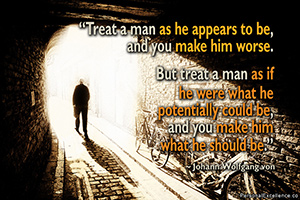
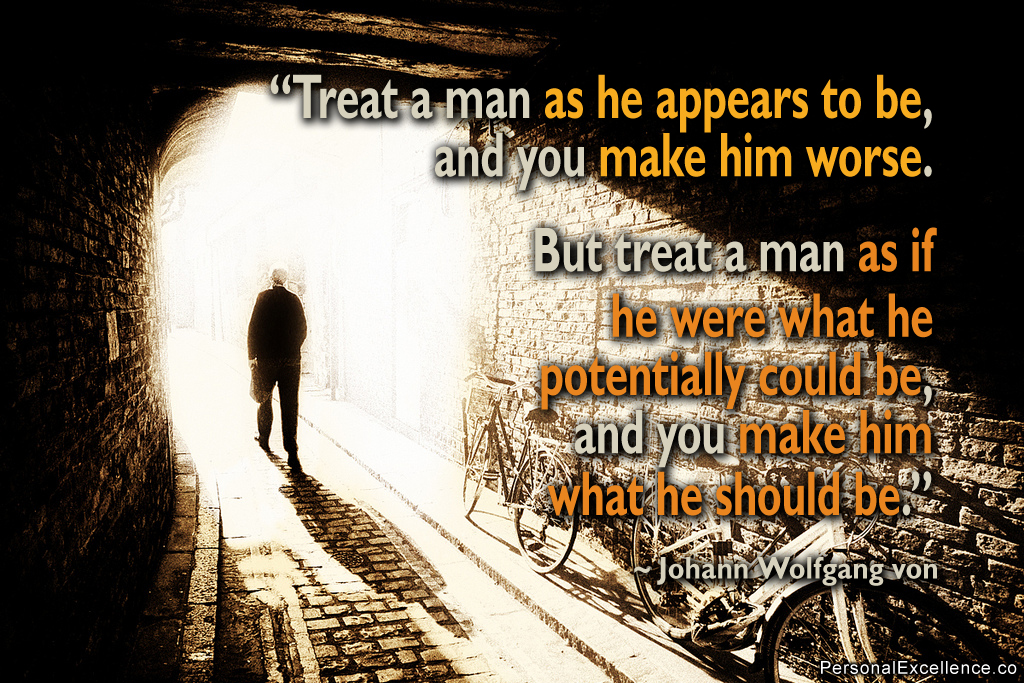




 If you like my articles, join my community of 65,000 readers and get my latest articles delivered to your inbox. Your email is safe. 100% no spam.
If you like my articles, join my community of 65,000 readers and get my latest articles delivered to your inbox. Your email is safe. 100% no spam.
Super collection. Really, amazing facts. After reading and while reading, I supposed that I in Holland.Thanks. :dance:
I wish bicycle culture was like this in the US. People look at you like you’re crazy for riding a bike half the time. The public transit there looks immaculate. Can you ever take bikes on the train? A certain car with bike accommodations perhaps? I recently got a folding bike so I could take it on the subway over here.
I haven’t seen anyone take bikes on the train actually. What my Dutch friend told me is that usually people cycle to a main train station, park their bicycle there, then take the train to a different place. Then when they alight, they’d have another bike at that station, which they use to commute to work. This is partly why everyone has an average of 2-3 bicycles.
As a student i commuted daily in holland. It’s during rushours very common that peoples use folding bikes to travel to the station and from the station to theire work.
It’s forbidden to take a normal bike on the train during rushours but after that you can take your bike with you. You have to buy a ticket for your bike so that’s why many people have a second or third bike on the station.
nice article about bicycles!
I checked the number of bicycles in Holland. There seems to be 19 million bicycles in Holland wich means 1.1 bike per person.
Personally i have three bikes 1 spare, 1 for the daily and 1 racing bike just for the sporting.
Trips of 100 km are normal on the racing bike and 80 km a day on the normal bike is possible when we go cycling for fun with the family.
Thanks Bert. Yes, thinking of something I can throw in the back of car actually, and take away if we travel to a different city. Places that would take a lot longer to get to on a bicycle alone!
Actually, they sell electric fold up bicycles here too. No idea how powerful those are.
Hi Celes, Thanks for your excellent article. The number of bicycles I see here beats the number I see in Tokyo.
You were thrilled being the pillion passenger behind the bicycle? It’s really hard for me to imagine what happens when you ride pillion on a motorcycle :-).
Rumio – Don’t tempt me!!! :D
Hi Celes, I love your articles on Holland. I’m a dutchman myself and I really enjoy how you talk about Holland. One thing about cycling: There is an extra cost, namely the fact that pants wear down quicker. (But that can be used as a reason to shop more often :D )
@Glenn, a fold up bicycle can be practical, but only when you travel partly with car/bus/train and the other part with the bike. If you do the whole ride on the bike I would recommend a normal bike. They aren’t that heavy to carry outside and since their wheels are bigger the cycling itself is much easier. Also make sure you have at least 3 gears (although 5 or 7 would be better) to switch to a lower gear when you have to cycle up a hill or against the wind (and ofcourse to a higher gear when you have the wind in your back)
Nice article Celes. I think it’s natural for there to be so many bicycles because the land is so flat. It wouldn’t be as practical around Sydeny for example, because there are so many steep hills.
By the way, have you seen anyone riding a fold up bicycle Celes? I’m hoping to get a fold up bicycle myself one day. They’re small, and usually come with a bag you can carry them in.
Great summary Celes and yes, the public transit in Europe is probably the best I’ve seen. Was in Berlin last summer and saw the same thing. I rate their transit system better than what we have here in Canada (and our’s is pretty good).
As for the cycles, I don’t think it was always like that as my first trip to Europe over 20 years ago, I don’t recall so many. Perhaps this is a response of the rising gas prices over the years. I wonder if there are many bike-pedestrian collisions over there.
Commenting for this post is closed.